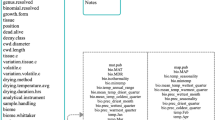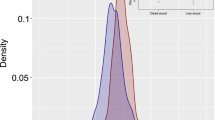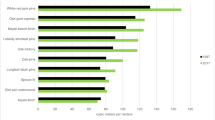Abstract
Wood carbon concentrations play a central role in forest carbon accounting, and are fundamentally linked to the growth strategies of woody plants. Yet there are no comprehensive assessments of wood carbon among trees globally, and coarse approximations of wood carbon (for example, 50%) are employed in virtually all benchmark models and assessments of forest carbon. We consolidated the largest database for any wood chemical trait—2,228 wood carbon observations from 636 species across all forested biomes—to derive robust wood carbon fractions for forest carbon accounting. Carbon fractions show substantial variation among forest biomes, and indicate errors in the existing forest carbon estimates of 4.8%, on average, and most extreme errors of 8.9% in tropical forests. The data also demonstrate that wood carbon concentrations show a phylogenetic signal and are co-evolved with, and negatively related to, wood density, thus representing a key plant trait that links plant functional biology to ecosystem processes worldwide.
This is a preview of subscription content, access via your institution
Access options
Access Nature and 54 other Nature Portfolio journals
Get Nature+, our best-value online-access subscription
$29.99 / 30 days
cancel any time
Subscribe to this journal
Receive 12 print issues and online access
$259.00 per year
only $21.58 per issue
Buy this article
- Purchase on Springer Link
- Instant access to full article PDF
Prices may be subject to local taxes which are calculated during checkout




Similar content being viewed by others
Data availability
The compiled data set used in our analyses is available through the TRY Functional Trait Database (data set ID number 433), and is available from the corresponding author upon request.
References
Pan, Y. D. et al. A large and persistent carbon sink in the world’s forests. Science 333, 988–993 (2011).
Kohl, M. et al. Changes in forest production, biomass and carbon: results from the 2015 UN FAO Global Forest Resource Assessment. Forest Ecol. Manag. 352, 21–34 (2015).
Keenan, R. J. et al. Dynamics of global forest area: results from the FAO Global Forest Resources Assessment 2015. Forest Ecol. Manag. 352, 9–20 (2015).
van der Werf, G. R. et al. CO2 emissions from forest loss. Nat. Geosci. 2, 829–829 (2009).
Canadell, J. G. & Raupach, M. R. Managing forests for climate change mitigation. Science 320, 1456–1457 (2008).
Asner, G. P. et al. High-resolution forest carbon stocks and emissions in the Amazon. Proc. Natl Acad. Sci. USA 107, 16738–16742 (2010).
Asner, G. P. Tropical forest carbon assessment: integrating satellite and airborne mapping approaches. Environ. Res. Lett. 4, 034009 (2009).
Clark, D. B. & Kellner, J. R. Tropical forest biomass estimation and the fallacy of misplaced concreteness. J. Veg. Sci. 23, 1191–1196 (2012).
USDA Agriculture and Forestry Greenhouse Gas Inventory: 1990–2008 Tech. Bull. 1930 (USDA, OCE, CCPO, 2011).
Saatchi, S. S. et al. Benchmark map of forest carbon stocks in tropical regions across three continents. Proc. Natl Acad. Sci. USA 108, 9899–9904 (2011).
Baccini, A. et al. Estimated carbon dioxide emissions from tropical deforestation improved by carbon-density maps. Nat. Clim. Change 2, 182–185 (2012).
Aalde, U. et al. in IPCC Guidelines for National Greenhouse Gas Inventories Vol. 4 (eds Eggleston, S., Buendia, L., Miwa, K., Ngara, T. & Tanabe, K.) Ch. 4 (IPPC, 2006).
Lamlom, S. H. & Savidge, R. A. A reassessment of carbon content in wood: variation within and between 41 North American species. Biomass Bioenerg. 25, 381–388 (2003).
Martin, A. R. & Thomas, S. C. A reassessment of carbon content in tropical trees. PLoS ONE 6, e23533 (2011).
Thomas, S. C. & Martin, A. R. Carbon content of tree tissues: a synthesis. Forests 3, 332–352 (2012).
Pettersen, R. C. in The Chemistry of Solid Wood (ed. Rowell, R.) 57–126 (American Chemical Society, Washington, 1984).
Martin, A. R., Thomas, S. C. & Zhao, Y. Size-dependent changes in wood chemical traits: a comparison of neotropical saplings and large trees. AoB Plants 5, plt039 (2013).
Becker, G. S., Braun, D., Gliniars, R. & Dalitz, H. Relations between wood variables and how they relate to tree size variables of tropical African tree species. Trees Struct. Funct. 26, 1101–1112 (2012).
Elias, M. & Potvin, C. Assessing inter- and intra-specific variation in trunk carbon concentration for 32 neotropical tree species. Can. J. Forest Res. 33, 1039–1045 (2003).
Thomas, S. C. & Malczewski, G. Wood carbon content of tree species in Eastern China: interspecific variability and the importance of the volatile fraction. J. Environ. Manag. 85, 659–662 (2007).
Zanne, A. et al. Global Wood Density Database (DRYAD, accessed 1 November 2017); https://doi.org/10.5061/dryad.234/1
Chave, J. et al. Towards a worldwide wood economics spectrum. Ecol. Lett. 12, 351–366 (2009).
Martin, A. R., Gezahegn, S. & Thomas, S. C. Variation in carbon and nitrogen concentration among major woody tissue types in temperate trees. Can. J. Forest Res. 45, 744–757 (2015).
Poorter, L. et al. Biomass resilience of Neotropical secondary forests. Nature 530, 211–214 (2016).
Boerjan, W., Ralph, J. & Baucher, M. Lignin biosynthesis. Annu. Rev. Plant Biol. 54, 519–546 (2003).
Martin, A. R., Erickson, D. L., Kress, W. J. & Thomas, S. C. Wood nitrogen concentrations in tropical trees: phylogenetic patterns and ecological correlates. New Phytol. 204, 484–495 (2014).
Myers, J. A. & Kitajima, K. Carbohydrate storage enhances seedling shade and stress tolerance in a neotropical forest. J. Ecol. 95, 383–395 (2007).
Diaz, S. et al. The global spectrum of plant form and function. Nature 529, 167–171 (2016).
Vance, C. P., Kirk, T. K. & Sherwood, R. T. Lignification as a mechanism of disease resistance. Annu. Rev. Phytopathol. 18, 259–288 (1980).
Thomas, S. & Martin, A. Data From: Carbon Content of Tree Tissues: A Synthesis (DRYAD, 2012); https://doi.org/10.5061/dryad.69sg2
Kattge, J. et al. TRY—a global database of plant traits. Global Change Biol. 17, 2905–2935 (2011).
Harmon, M. E., Fasth, B., Woodall, C. W. & Sexton, J. Carbon concentration of standing and downed woody detritus: effects of tree taxa, decay class, position, and tissue type. Forest Ecol. Manag. 291, 259–267 (2013).
Gao, B. L., Taylor, A. R., Chen, H. Y. H. & Wang, J. Variation in total and volatile carbon concentration among the major tree species of the boreal forest. Forest Ecol. Manag. 375, 191–199 (2016).
Jones, D. A. & O’Hara, K. L. The influence of preparation method on measured carbon fractions in tree tissues. Tree Physiol. 36, 1177–1189 (2016).
Pompa-Garcia, M., Sigala-Rodriguez, J. A., Jurado, E. & Flores, J. Tissue carbon concentration of 175 Mexican forest species. iForest 10, 754–758 (2017).
Delignette-Muller, M. L. & Dutang, C. fitdistrplus: an R package for fitting distributions. J. Stat. Softw. 64, 1–34 (2015).
Pinheiro, J et al. nlme: Linear and Nonlinear Mixed Effects Models (CRAN-R, 2016).
Lenth, R. V. Least-squares means: the R package lsmeans. J. Stat. Softw. 69, 1–33 (2016).
Paradis, E., Claude, J. & Strimmer, K. APE: analyses of phylogenetics and evolution in R language. Bioinformatics 20, 289–290 (2004).
Webb, C. O. & Donoghue, M. J. Phylomatic: tree assembly for applied phylogenetics. Mol. Ecol. Notes 5, 181–183 (2005).
Webb, C. O., Ackerly, D. D. & Kembel, S. W. Phylocom: software for the analysis of phylogenetic community structure and trait evolution. Bioinformatics 24, 2098–2100 (2008).
Wikstrom, N., Savolainen, V. & Chase, M. W. Evolution of the angiosperms: calibrating the family tree. Proc. R. Soc B 268, 2211–2220 (2001).
Gastauer, M. & Meira-Neto, J. A. A. An enhanced calibration of a recently released megatree for the analysis of phylogenetic diversity. Braz. J. Biol. 76, 619–628 (2016).
Blomberg, S. P., Garland, T. & Ives, A. R. Testing for phylogenetic signal in comparative data: behavioral traits are more labile. Evolution 57, 717–745 (2003).
Kembel, S. W. et al. Picante: R tools for integrating phylogenies and ecology. Bioinformatics 26, 1463–1464 (2010).
Chave, J. et al. Regional and phylogenetic variation of wood density across 2456 neotropical tree species. Ecol. Appl. 16, 2356–2367 (2006).
Lefcheck, J. S. piecewiseSEM: Piecewise structural equation modeling in R for ecology, evolution, and systematics. Methods Ecol. Evol. 7, 573–579 (2016).
Felsenstein, J. Phylogenies and the comparative method. Am. Nat. 125, 1–15 (1985).
Garland, T., Harvey, P. H. & Ives, A. R. Procedures for the analysis of comparative data using phylogenetically independent contrasts. Syst. Biol. 41, 18–32 (1992).
Thomas, S. C., Martin, A. R. & Mycroft, E. E. Tropical trees in a wind-exposed island ecosystem: height–diameter allometry and size at onset of maturity. J. Ecol. 103, 594–605 (2015).
Acknowledgements
The authors thank K. L. Smith for helpful comments that improved the manuscript. This research was supported by a graduate research bursary to D.M. provided by the Department of Physical and Environmental Sciences at the University of Toronto Scarborough, Canada. S. C. Thomas was supported by funding from the Natural Science and Engineering Research Council of Canada.
Author information
Authors and Affiliations
Contributions
A.R.M. and S.C.T. conceived the study. A.R.M. led the manuscript preparation and final analyses. M.D. led the data compilation and preliminary data analysis. S.C.T. and M.D. helped write and edit the manuscript.
Corresponding author
Ethics declarations
Competing interests
The authors declare no competing interests.
Additional information
Publisher’s note: Springer Nature remains neutral with regard to jurisdictional claims in published maps and institutional affiliations.
Supplementary information
Supplementary Information
Supplementary Figures 1–3 and Supplementary Tables 1–4.
Rights and permissions
About this article
Cite this article
Martin, A.R., Doraisami, M. & Thomas, S.C. Global patterns in wood carbon concentration across the world’s trees and forests. Nature Geosci 11, 915–920 (2018). https://doi.org/10.1038/s41561-018-0246-x
Received:
Accepted:
Published:
Issue Date:
DOI: https://doi.org/10.1038/s41561-018-0246-x
This article is cited by
-
Effects of climate and plant functional types on forest above-ground biomass accumulation
Carbon Balance and Management (2023)
-
Carbon pool dynamics after variable retention harvesting in Nothofagus pumilio forests of Tierra del Fuego
Ecological Processes (2023)
-
The carbon sink of secondary and degraded humid tropical forests
Nature (2023)
-
Carbon dioxide emissions through land use change, fire, and oxidative peat decomposition in Borneo
Scientific Reports (2023)
-
Nation-wide mapping of tree-level aboveground carbon stocks in Rwanda
Nature Climate Change (2023)



